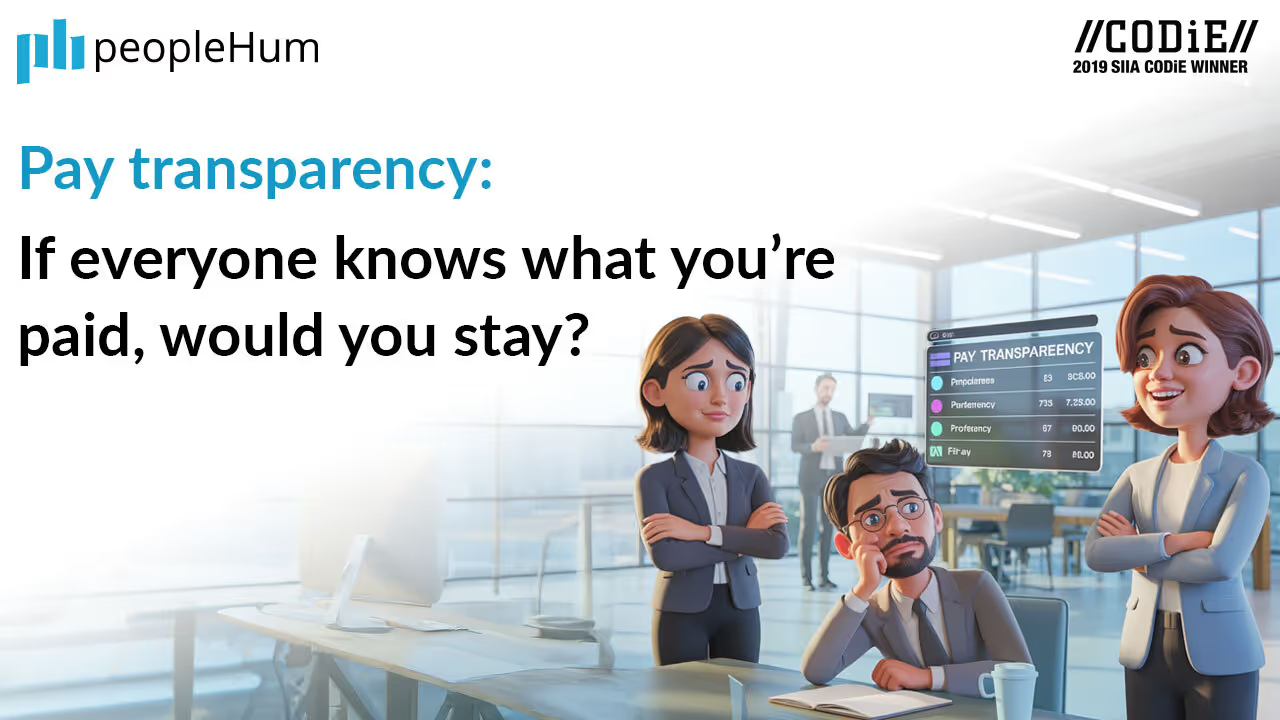Imagine walking into your office, and casually overhearing your coworker spill the beans about their paycheck. Not because they’re bragging, but because it’s plastered on a company’s wide dashboard for all to see. Your salary, their salary, the CEO’s salary, everything out in the open. No secrets, no whispers, just cold numbers staring you in the face. Would you high-five your desk mate for earning more, or would you start drafting your resignation letter? This is the new world of pay transparency, and it’s shaking up workplaces.
For decades, we’ve all lived by the unwritten rule: Don't Ask, Don't Tell. Compensation was a sacred, silent pact between an employee and the company. It was private, personal, and a little bit taboo. But let’s face it, that game is over. The curtain is being pulled back, and the audience isn’t just your team. It's everyone.
What even is pay transparency?
Pay transparency is when a company stops playing hide-and-seek with its compensation data. Salaries, bonuses, stock options everything’s out in the open, whether it’s just for employees to see or the entire world. It feels like your years of hard work, loyalty, and dedication have been completely ignored. You don't just feel underpaid; you feel disrespected. It is the central anxiety of pay transparency that can lead to some serious morale issues if not handled with absolute precision. The answers need to be solid, fair, and backed by data. Without a clear rationale, pay transparency can backfire spectacularly. It can create resentment, a sense of being undervalued, and a mad dash for the door.
There are different flavors of transparency, each with its own spice:
- Partial transparency: Sharing salary ranges for roles, usually in job postings, but keeping individual paychecks locked away. Think “$50k-$70k” on a job board, vague but helpful.
- Internal transparency: Everyone inside the company gets a peek at the payroll. Employees can see their colleagues’ salaries, bonuses, and maybe even how raises are calculated.
- Full public transparency: The boldest move, making pay data public for anyone with an internet connection to dissect. Think annual reports or websites broadcasting every employee’s compensation.
Can pay transparency be your secret weapon?
Before you swear off transparency: it’s not all doom and gloom. If done right, it can transform your workplace for the better. Here’s why HR should consider jumping on board.
- Trust is the ultimate currency Employees hate feeling like they’re being kept in the dark. Secret salaries breed distrust while transparency sends a clear message: “We’re not playing games.” It shows employees you’re committed to fairness, which can boost loyalty and.Trust isn’t just nice, it’s a retention superpower.
- It forces you to get your act together Knowing salaries will be exposed, forces HR to audit pay scales, root out biases, and create a system that makes sense, the result is a workplace that’s fairer and more defensible.
- It’s a magnet for talent In today’s job market, candidates aren’t here for surprises. They want to know what they’re getting into. Clear salary ranges in job postings cut through the noise of “competitive pay” fluff. For HR, this is a chance to stand out and attract top talent.
- It evens the odds Pay secrecy often hits marginalized groups hardest Transparency levels the playing field by making it harder for biases to hide.
The risks: When transparency goes wrong
Pay transparency isn’t a cure-all. If you roll it out carelessly or your pay system’s already a trainwreck, you’re asking for trouble. Here’s what HR needs to brace for.
- It Can Spark a Grudge Fest When employees see pay differences they don’t get, they don’t just nod and move on they stew. They whisper in Slack channels. Transparency can amplify those feelings if you don’t have a plan to explain and address gaps.
- Work Grinds to a Halt Transparency without clear communication can tank productivity. Employees get distracted, morale dips, and suddenly, HR’s dealing with a disengaged workforce.
- Public Scrutiny Can Sting If you go all-in with public transparency, get ready for the world to weigh in. Competitors, industry blogs, even random social media users will pick apart your pay structure. If it looks unfair or just plain odd, you’re in for a PR headache. HR needs to think strategically to avoid handing critics a free megaphone.
The legal push: Transparency isn’t optional anymore
HR can’t dodge this one. Governments are cracking down on pay secrecy, and the pressure’s only growing. In the U.S., states like California, New York, and Colorado now mandate salary ranges in job postings. Ignoring these rules could mean fines, lawsuits, or a trashed reputation.
Even without laws, candidates are demanding transparency. Job postings without salary ranges get 30% fewer applications. For HR, this means transparency isn’t just a nice-to-have, it's a must to stay competitive and credible.
Why pay transparency keeps HR up at night
For HR managers and CHROs, pay transparency is like hosting a company-wide talent show where everyone’s performance is judged except it’s payroll on stage, and the audience isn’t holding back. Here’s why this shift is a game-changer, and not always the fun kind.
No more hiding behind “Market rates”
When salaries are secret, HR can lean on vague excuses to justify pay gaps: “It’s the market,” or “Budgets are tight.” But transparency flips the script. You’ve got to explain why one employee earns more than another for similar work. If the answer boils down to “they negotiated better,” prepare for some serious side-eye. Transparency demands a rock-solid pay structure, and that means HR needs to build systems that hold up under scrutiny. No more winging it.
It puts your flaws on blast. Not every pay system is a work of art
Maybe some employees are overpaid because of old-school tenure rules, or others are underpaid due to sloppy hiring practices. Transparency is like turning on the lights in a cluttered basement suddenly, everyone sees the mess. HR has to face tough questions about fairness, consistency, and whether the company’s been cutting corners. It’s not pretty, but it’s real.
The comparison trap Is real
When pay is out in the open, employees don’t just check their own numbers they obsess over everyone else’s. That coworker who’s always late? They’re making how much? The new hire fresh out of school? Why are they earning almost as much as a veteran? This comparison game can sour team dynamics faster than a bad office potluck.
Retention becomes a high-stakes gamble
If everyone knows your paycheck will you stay back? Transparency can make some employees feel valued, especially if their pay stacks up well. But others might bolt if they spot a gap whether they’re underpaid and pissed or overpaid and paranoid about layoffs.
Here’s how HR can nail pay transparency without crashing and burning
Implementing pay transparency requires a clear, strategic approach to avoid internal chaos. Here's how HR can successfully roll it out.
Audit your pay structure
Audit your compensation like it’s a crime scene. Map out every role, salary, and bonus.. Spot gaps whether it’s gender-based, tenure-related, and fix them. Identify and correct any existing pay gaps, whether they're based on gender, tenure, or other factors. Presenting a broken system will only create resentment and distrust.
Craft a pay philosophy that makes sense
Draft a policy that clearly explains all factors- skills, experience, performance and determines an employee's compensation. When people understand the logic behind the numbers, they're more likely to accept them.
Communicate your job
Transparency without context is a recipe for disaster. Hold Q&A sessions and be ready for hard questions like, “Why does my teammate earn more?” and have honest, data-backed answers ready to go.
Take a phased approach
You don't have to go from secrecy to full transparency overnight. Start small and ease into it. This gradual approach allows your company culture to adapt and prevents a sudden shock to the system.
Conclusion: Will you stay or leave?
Pay transparency can build trust, attract top talent, and force you to create a fairer system. This visibility can be a massive motivator, making them more engaged and committed to the company's success.
But it can also stir up resentment, derail productivity, and invite unwanted scrutiny if you’re not prepared. The difference lies in execution. Audit your pay, build a clear policy, over-communicate, and train your team to handle the fallout. Get it right, and transparency becomes a competitive edge. Get it wrong, and you’re putting out fires for months. The days of secret salaries are fading fast. Step up now, or keep wondering if your paycheck was public knowledge, would you stick around?
FAQs
1. What is pay transparency in the workplace?
Pay transparency means openly sharing salary ranges or compensation structures with employees. It builds fairness but also challenges organizations to justify every pay decision clearly.
2. What are the main benefits of pay transparency?
It boosts trust, engagement, and retention when done right. Employees feel respected when pay decisions are data-driven and aligned with performance—not favoritism.
3. What are the risks of implementing pay transparency too soon?
Without communication and clear rationale, it can trigger jealousy, resentment, or attrition. Transparency without context often creates noise, not trust.
4. How does pay transparency impact retention and morale?
When employees see fair pay practices, they’re more loyal and motivated. But when inequities are revealed without correction, morale can take a sharp hit.
5. How should HR roll out a transparent pay policy?
Start by conducting an internal pay equity audit, define salary bands, and train managers to discuss compensation openly. HR must set the narrative before rumors do.
6. Is pay transparency really the future of compensation strategy?
Yes, because employees now expect openness. Companies that embrace transparency strategically will attract top talent and maintain stronger reputations in competitive markets.


















































